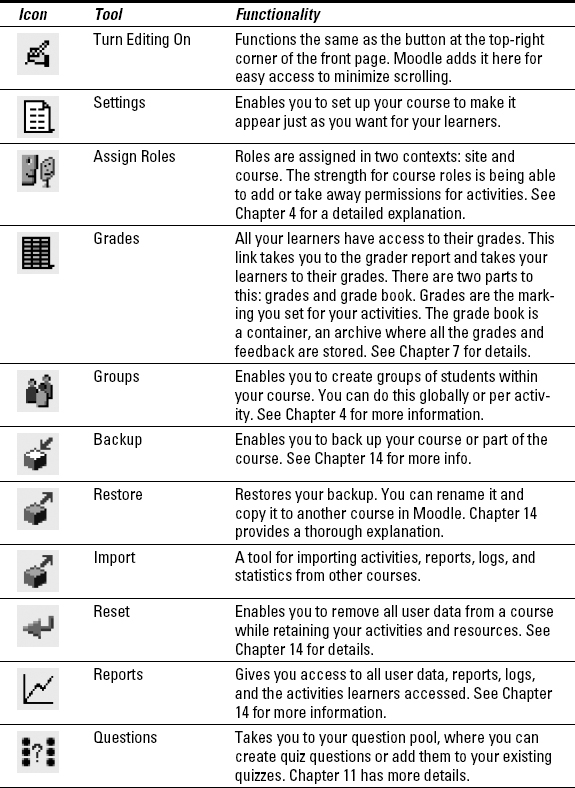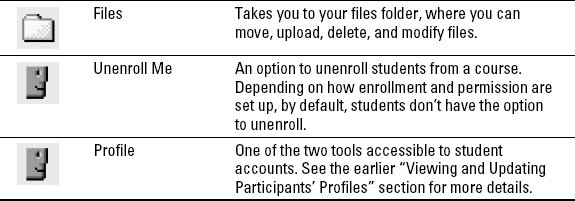Course Blocks
Blocks provide extra tools and features to your course. Moodle enables a number of blocks by default (refer to Figure 3-2) when the course is created, and these blocks appear in the left and right columns of the Moodle interface. Moodle enables you to add more functionality to your front page from the main blocks drop-down menu, which only appears when editing is turned on. (Refer to Figure 3-5.) You can relocate blocks or close them so that they aren't accessible. Read on for explanations of the blocks and how your learners can benefit from them.
Default blocks
The following blocks, by default, appear on the left:
- Activities: Lists all activities and resources you set up for your students. As soon as you set an activity, Moodle lists it in this block, and it becomes an active link to a table displaying quick access to these activities. The links include the generic titles such as quizzes, forums, chats, lessons, wikis, and resources. This block is a handy overview and a quick way to get to an activity. See the section “Resources and Activities,” later in the chapter, for even more details.
- Search Forums: A search text field enabling you and your learners to search all the course forums for a word or phrase. This block supports simple searching, such as typing words with spaces. For exact matching, use a plus sign (+). For an exact phrase, use quotation marks around the phrase “like this”. Click the Advanced Search link if you want to use a more sophisticated search. This block is useful if you have many forums and many learners using them. I tend to position the Search Forum block below the Administration block on the left.
- Administration: Soon to become your Moodle best friend! This block is where you can find tools for managing your learners, enrollment, your course setting, access your files, and more. The majority of the tools are visible only to you, and your learners get to see just two tools: Grades and Profile. Table 3-4 lists all the tools and icons and gives a short explanation for each.
Table 3-4 The Administration Block Tools


- Course Categories (or Courses): The Courses block lists the categories and/or courses in the Moodle site. This block enables you to move among the courses. It's useful to your learners if they are enrolled in more than one Moodle course because they can quickly navigate among the courses.
The following blocks, by default, appear on the right:
- Latest News: Posts made to the News Forum are highlighted in this block, including a link to access the older news postings. Moodle is set up to show three latest news item. You can change this to display more or fewer new items: In the course Administration block on the left, click the Settings link and then click the News Items to view the latest news posted to the news forum.
- Upcoming Events: When you post an event to the calendar (available as an additional block; see the following section) and when you set dates in activities such as assignments, the events are listed in the Upcoming Events block. The listing is a link to the event as well as a useful reminder for your learners. Moodle provides so many different modules listing deadlines, your learners won't be able to find an excuse.
- Recent Activities: This block lists the activities you post as well as the updates you make to the resources or assignments.
Additional blocks
When you turn on editing (by clicking the Turn Editing On button at the top-right corner), the Blocks drop-down list appears with several utilities you can add (many of them very useful and which I use regularly). I describe each in this list:
- Blog Tags and Blog Menu: See Chapter 8 for details on how the Blog Tags and Blog Menu blocks are displayed.
- Calendar: I always enable the Calendar block as soon as I set up a course and move it up left or right side, so learners can easily see it. As soon as you set up an activity or a resource, it gets listed in the calendar. An administrator can create calendars to be listed on the site front page informing all users about events related to all courses. For example, if the site administrator will be running maintenance on the server and there will be a certain period of time when users won't be able to log in, the date(s) and time(s) can be listed in the site calendar. Instructors (those with the Teacher role) can also enable one or more calendars for their courses. Events can be exported into other calendars or software programs.
After enabling the calendar, the following tricks can help enter listings:
- • Color coding: Notice the color-coded key used for events listed for everyone in a course, for groups, and for users only.
- • Adding entries: To add an entry to a day (remember: due dates on activities are automatically pushed to the calendar), click the month. The month is a link that takes you to a full calendar view page.
- • Adding events: When you click the New Event button, Moodle takes you to a new window. Follow the instructions — the fields are straight forward. Make sure you click the Save Changes button on the last screen.
- Global Search: The Global Search block provides user with a search input box that searches the complete Moodle course. Advanced search features are available.
- HTML: Use this block to create your own unique block for the front page. By using the HTML capabilities, you can add media (such as images, video, and sound). You don't have to give the block a name; you can leave it totally blank and just add an image.
- Loan Calculator: A basic calculator enabling your learners to calculate interest rates.
- Mentees: This block enables an instructor to set up mentor roles and gives mentors quick access to their own profile pages. Mentors can be anyone who has a relationship to your learner — for example, a parent, industry supervisor, or really anyone working with a learner who may want/need access to the Moodle course. The block becomes activated only when the mentor role is activated. This particular role must be assigned viewing permission and then assigned to the student account he or she will view. See Chapter 4 for more detailed explanation.
- Network Server: This is an admin functionality you may have permission to enable. It allows learners to access different Moodle sites to enroll in a course.
- Online Users: This block shows a list of all users logged in to your course. The list is refreshed every 5 minutes. You can enable and delete this block, though if don't have administrative privileges, you can't change the time setting for refreshing the list.
 If part of your assessment is looking at how long students are viewing your course material, a good check is to look at log files and reports and view the activities students have accessed. Just looking at whether they're logged in is not a conclusive measure of being an active participant.
If part of your assessment is looking at how long students are viewing your course material, a good check is to look at log files and reports and view the activities students have accessed. Just looking at whether they're logged in is not a conclusive measure of being an active participant. - Quiz Results: This block enables you to choose a quiz (there must be a quiz in the course for this block to be enabled) and show the highest and/or lowest grades on the front page. After you bring up the block, you need to select the Editing icon and configure the block. You can select the quiz (if you have more than one in the course), how many highest/lowest grades to show, whether to show the grades anonymously, and the format of the grades (percentages, fractions, or absolute numbers). Figure 3-10 shows the editing screen (on the left) and how the block is displayed when configured.
Figure 3-10: Including a Quiz Results block in your course.

- Random Glossary Entry: You can use this block with your glossary to randomly show various entries. You can also use this block editing text box for other goals such as an image or a quote of the day. The block entry changes every time the front page is refreshed. For more information about the glossary, see Chapter 9. Note that you need to configure the tool by using the edit icon and completing a number of fields.
- Remote RSS Feeds: This tool enables you to add newsfeeds from external resources, such as Web sites, to show up in your Moodle course front page (or site). You can add news headlines, journal article releases, recently added documents, and so on. When you enable this block, you're given a link telling you to configure it. Follow the Moodle instructions.
- Section Links: This block enables you and your learners to quickly access week or unit sections in your course. Whether you set up the course by weeks or topics, the numbers that appear in this block act as links to the particular sections. This block is useful if you have many topics. I tend to use it over 10 weeks of units. If you make use of this block, it works best to move it up, so it's clearly visible. I tend to position it right under the People block.
- Tags: Anything tagged in your course glossary or blog appears in this block. It can be overwhelming and messy, and I recommend that if you use tags, use them for blocks or glossary entries only.
Moodle has few other useful blocks you can download by visiting the http://moodle.org modules and plugins database. Some of the blocks that have been added include: YouTube, Flickr, Side Bar, Progress Bar, Unanswered Discussions, and Simple Clock.
